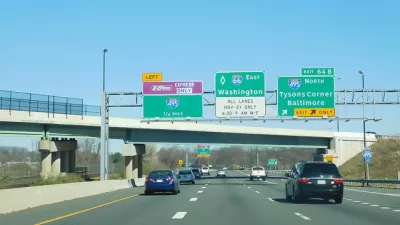The lanes are in use now, operating as High Occupancy Vehicle (HOV) lanes during peak hours. Come December, solo-occupant vehicles will be able to use the converted lanes, providing they have E-ZPass transponders. However, there are some losers.
The losers are those with "Clean Special Fuel plates," e.g., hybrids and electric vehicles, which have been using the HOV lanes by solo drivers. The Virginia Department of Transportation refers to these low or zero emission vehicles generically as "hybrid vehicles." In California, traditional hybrid vehicles, without plug-in battery charging capability, lost their special privileges over six years ago.
Come December, all "clean fuel" vehicles will need to have at least one passenger to use the I-66 HOT lanes toll-free, according to Luz Lazo, transportation reporter for The Washington Post, who has been chronicling the new lanes since at least July.
The new 10 miles of HOT lanes on I-66 are "inside-the-Capital Beltway," from Route 29 in Rosslyn to Interstate 495.
Unlike the 495 and 95 Express Lanes in Northern Virginia that operate 24-7, the I-66 HOT lanes will only function during peak hours and in the peak direction, i.e., they will operate like general purpose lanes during all other times. However, those hours have been expanded. "The new peak hours will be 5:30 to 9:30 a.m. eastbound and 3 to 7 p.m. westbound."
For commuters, adjusting to the new requirements and rules may be the biggest challenge in coming months. This will be the first rush-hour-only, peak-period toll system of its kind in the United States.
All vehicles except motorcycles that use the HOT lanes will need to have E-ZPass accounts. Carpoolers will need to switch to "HOV mode."
Planetizen has also been chronicling the conversion and addition of the new HOT lanes with five posts since June 2015.
Hat tip to Kenyon Karl.
FULL STORY: Virginia’s latest experiment with toll lanes to test thousands of commuters on I-66

Alabama: Trump Terminates Settlements for Black Communities Harmed By Raw Sewage
Trump deemed the landmark civil rights agreement “illegal DEI and environmental justice policy.”

Planetizen Federal Action Tracker
A weekly monitor of how Trump’s orders and actions are impacting planners and planning in America.

How Atlanta Built 7,000 Housing Units in 3 Years
The city’s comprehensive, neighborhood-focused housing strategy focuses on identifying properties and land that can be repurposed for housing and encouraging development in underserved neighborhoods.

In Both Crashes and Crime, Public Transportation is Far Safer than Driving
Contrary to popular assumptions, public transportation has far lower crash and crime rates than automobile travel. For safer communities, improve and encourage transit travel.

Report: Zoning Reforms Should Complement Nashville’s Ambitious Transit Plan
Without reform, restrictive zoning codes will limit the impact of the city’s planned transit expansion and could exclude some of the residents who depend on transit the most.

Judge Orders Release of Frozen IRA, IIJA Funding
The decision is a victory for environmental groups who charged that freezing funds for critical infrastructure and disaster response programs caused “real and irreparable harm” to communities.
Urban Design for Planners 1: Software Tools
This six-course series explores essential urban design concepts using open source software and equips planners with the tools they need to participate fully in the urban design process.
Planning for Universal Design
Learn the tools for implementing Universal Design in planning regulations.
Jessamine County Fiscal Court
Caltrans
Institute for Housing and Urban Development Studies (IHS)
City of Grandview
Harvard GSD Executive Education
Toledo-Lucas County Plan Commissions
Salt Lake City
NYU Wagner Graduate School of Public Service




























